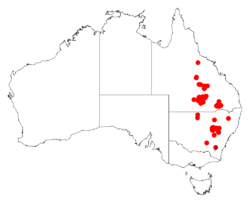Biology:Acacia ixodes
| Motherumbung | |
|---|---|
| Scientific classification | |
| Kingdom: | Plantae |
| Clade: | Tracheophytes |
| Clade: | Angiosperms |
| Clade: | Eudicots |
| Clade: | Rosids |
| Order: | Fabales |
| Family: | Fabaceae |
| Subfamily: | Caesalpinioideae |
| Clade: | Mimosoid clade |
| Genus: | Acacia |
| Species: | A. ixodes
|
| Binomial name | |
| Acacia ixodes Leslie Pedley
| |

| |
| Occurrence data from AVH | |
Acacia ixodes, commonly known as motherumbung,[1] is a shrub belonging to the genus Acacia and the subgenus Phyllodineae that is native to parts of eastern Australia .
Description
The shrub typically grows to a height of 2 to 7 m (6 ft 7 in to 23 ft 0 in) and has an erect and spreading habit. It has glabrous and resinous branchlets that are angled or flattened towards the apices.[2] Like most species of Acacia it has phyllodes rather than true leaves. The narrowly elliptic to linear or linear-oblanceolate shaped glabrous to resinous phyllodes are straight to slightly curved with a length of 2.5 to 5 cm (0.98 to 1.97 in) and a width of 2 to 5 mm (0.079 to 0.197 in) and has a prominent midvein with faint lateral veins. It produces yellow flowers between August and November. The simple inflorescences occur singly in the axils and have spherical to ovoid shaped flower-heads with a diameter of 4.5 to 7 mm (0.18 to 0.28 in) containing 20 to 30 bright yellow flowers.[2]
Taxonomy
The species was first formally described by the botanist Leslie Pedley in 1980 as part of the work A revision of Acacia Mill. in Queensland as published in the journal Austrobaileya. It was reclassified as Racosperma ixodes by Pedley in 1987 then transferred back to genus Acacia in 2001. The only other synonym is Acacia gnidium var. latifolia.[3] The specific epithet is a reference to the sticky nature of new shoots and immature phyllodes.[2]
Distribution
The shrub has a wide distribution through central New South Wales extending into Queensland. In New South Wales the bulk of the population is situated between Dubbo to around Gilgandra and Mendooran[2]
See also
References
- ↑ "Species profile — Acacia ixodes". Queensland Government. https://apps.des.qld.gov.au/species-search/details/?id=14917.
- ↑ 2.0 2.1 2.2 2.3 "Acacia ixodes Pedley". PlantNet. Royal Botanic Garden, Sydney. http://plantnet.rbgsyd.nsw.gov.au/cgi-bin/NSWfl.pl?page=wattle&lvl=sp&name=Acacia~ixodes.
- ↑ "Acacia ixodes Pedley". Atlas of Living Australia. Global Biodiversity Information Facility. https://bie.ala.org.au/species/https://id.biodiversity.org.au/node/apni/2889215#names.
Wikidata ☰ Q9565707 entry
 |

